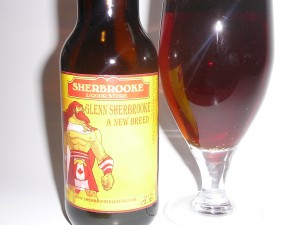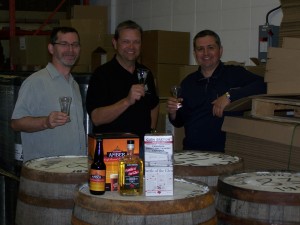 One of the more interesting beer releases this fall comes none other than Sherbrooke Liquor Store. For the few of you who are uninitiated with this creature, Sherbrooke Liquor has the best retail beer selection in Canada. But not content to stop there, they also contract to produce private brand beer sold (mostly) exclusively at their store. I think they are up to 14 or 15 different releases over the past four years. Many are curious, most are creative – ranging from green beer to double IPAs to coconut curry porters.
One of the more interesting beer releases this fall comes none other than Sherbrooke Liquor Store. For the few of you who are uninitiated with this creature, Sherbrooke Liquor has the best retail beer selection in Canada. But not content to stop there, they also contract to produce private brand beer sold (mostly) exclusively at their store. I think they are up to 14 or 15 different releases over the past four years. Many are curious, most are creative – ranging from green beer to double IPAs to coconut curry porters.
The latest Sherbrooke release is Glenn Sherbrooke, a barrel-aged amber ale. Sherbrooke is not new to barrel-aged beer, having done Rye Dawn a couple of years back.

Your Humble Writer, Neil Herbst from Alley Kat and Lauchie MacLean from Glenora hover over the about to be filled barrels
What makes this release unique is that this time the beer was aged in single malt barrels from the Glenora Distillery in Cape Breton. More specifically the barrels held Glen Breton, the highly controversial single malt “don’t call it scotch” whiskey produced by Glenora.
Glen Breton is Canada’s only single malt barley whiskey, and it has been embroiled in an almost 10 year long legal battle with the Scotch Whisky Association over their use of the word “Glen” as well as the word “scotch”. In 2009 they finally won – at least in Canada – the right to use the short four-letter word. Earlier this year they released their first Glen Breton, a 15-year-old single malt quite light in body and colour.
At any rate, Glenora sent a few barrels out to Alberta for use by Sherbrooke and Alley Kat Brewing to create their own version of a single malt barrel-aged beer – possibly to piss off another Scottish mainstay in Innis and Gunn.
Alley Kat used their Amber Ale, which is a southern English Brown Ale, as the base beer, leaving it in the barrel for 96 days. Interestingly, the beer took up A LOT of ethanol, jumping from a dark brown 5% beer to a 12.2% amber-hued creation.
 Oak-aged beer can be unpredictable. Each batch will taste quite different and even the brewer can’t tell how the beer will react with the wood and residual spirit. So, how did this first effort fare?
Oak-aged beer can be unpredictable. Each batch will taste quite different and even the brewer can’t tell how the beer will react with the wood and residual spirit. So, how did this first effort fare?
As mentioned, it pours a dark copper colour, much lighter than the beer going in, with a thick, tight off-white head that lasts and deposits noticeable lacing. The aroma is distinctively woody, with some sharp alcohol notes and some butterscotch, peat and cherry. There is no mistaking that this beer spent a good time in oak. The sip presents light caramel and toffee malt upfront accented by a slick butterscotch sweetness. It is then overrun by a woody scotch-like warming. I detect a touch of lactic sourness, giving the beer a hint of a Flanders Red character. In many respects it tastes like the inside of an oak single malt barrel, which is maybe how it should be.
The most notable – and hazardous – part of this beer is that it goes down quite smooth, with hardly a trace of its potent alcohol content. Yes, there are alcohol notes, but somehow the beer seems too smooth and light for its significant punch. So be careful, young drinker.
The beer is not perfect. It may be a bit one-dimensional and almost too strong in alcohol. And the single malt underneath the beer may not be up to the task of being a full partner in the beer. However, I find myself wondering if this is what Innis and Gunn would taste like if they let themselves go all out. I have a number of oak-aged beer and I appreciate it is a very challenging style to do right. Almost always one quality or another dominates to the detriment of overall drinkability. This one does a pretty good job of remaining drinkable.I look forward to the second attempt (which I am told there will be one).
Just don’t have two and think you can drive home.


November 5, 2010 at 3:48 PM
Glenn was #14, Heartstopper is #15. Hans Across The Water will be #16 and our upcoming Jack Daniels beer will be #17. (Unless the Olde Deuteronomy in Glen Breton barrels comes first, but I have a sneaking suspicion it’s a way down the road.) Then, drumroll please, in keeping with the Alley Kat 15’th Anniversary, #18, will be the 15’th beer we’ve done with them, so it will be 15 for 15 or something like that. It’s called Mojo A’Peel. More on this later. (Our original intention had been to slide it in at the tail end of their series, but it looks like that won’t time out exactly right. Close enough though.
As for Glenn, I requested the barrels from Glenora, so they had no intention (nor do I) of slighting Innis & Gunn. For us, it was a good opportunity, for them- it’s a chance to explore the potential of another revenue stream.
All things being equal, we always intended to experiment with the base beer. While the OD is eagerly awaited, it’s certainly possible that something else can be used too. We shall see.
Jim.
November 8, 2010 at 9:13 AM
I’ve had 2 bottles so far and I have been impressed by the effort. Not sure what happened with the Rye Dawn – that was a total failure but I’m glad the effort was there. When are the new batch (es) of Glen set for release?